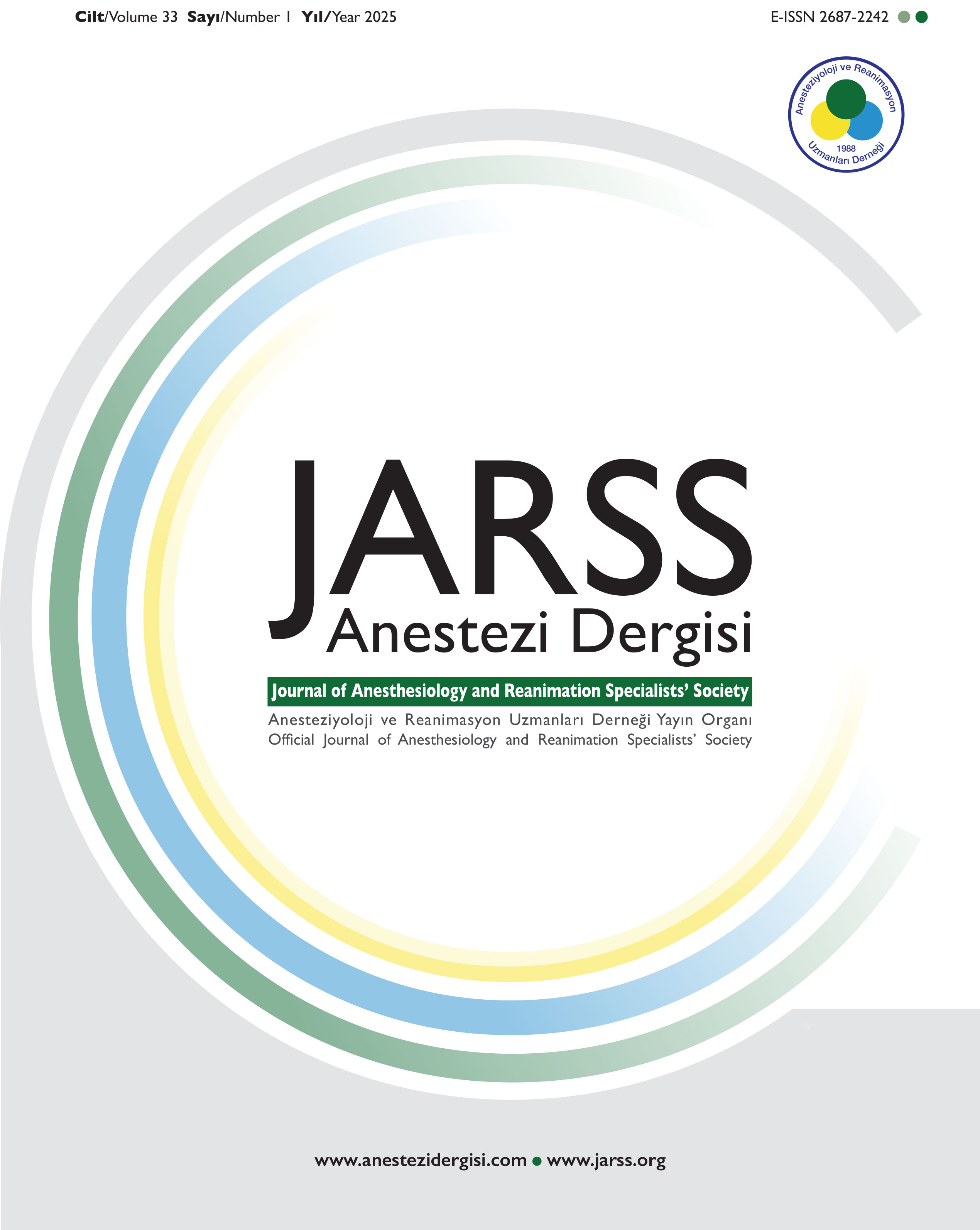Toraks Cerrahisi Hastalarında Lateral Dekübit Pozisyonda, İnvaziv Olmayan Dinamik Monitörizasyon Sıvı Yanıtlılığını Değerlendirmede Faydalı mıdır?
Hija Yazicioglu1, Sumru Sekerci1, Hulya Yigit Ozay1, Mustafa Bindal1, Sumeyye Nur Aydin21Sağlık Bilimleri Üniversitesi Ankara Bilkent Şehir Hastanesi, Anesteziyoloji ve Reanimasyon Ana Bilim Dalı, Ankara, Türkiye2İstanbul İl Sağlık Müdürlüğü, Halk Sağlığı Departmanı, İstanbul, Türkiye
Amaç: Pleth variability indeks (PVI), perioperatif ve yoğun bakımda hastanın volüm durumunu gösteren invaziv olmayan ve sürekli dinamik ölçüm yapan bir trend monitörüdür. Pleth variability indeks eşik değeri pek çok hasta grubu ve cerrahi tipinde büyük değişiklik göstermektedir. Torasik cerrahide az rastlanılan bu çalışmada hastaların lateral pozisyonda iken ve daha sonra yapılan mini sıvı cevaplılık testi sonrası volüm durumunu, PVI ve ortalama arter basıncı (OAB) ile değerlendirdik.
Yöntem: Hastane etik komitesi izni ve hasta onam formları alındıktan sonra sağ veya sol yan pozisyonda açık torakotomi yapılacak toplam 63 hasta çalışmaya dahil edildi. Preoperatif rutin 8-10 saat aç kalan ve supin yatan hastalara (T1) rutin monitörizasyon yanında Masimo Root-7 ile PVI ve invazif arter monitörizasyonu yapıldı. İndüksiyonu takiben (T2) ve hastalar sağ veya sol yana çevrilip stabil olduktan sonra (T3) tüm değerler yazıldı. Hastalara ideal vücut ağırlığına göre 3 mL kg⁻¹ ringer laktat 3 dakika içinde verildikten sonra (T4) son kayıtlar yapıldı ve insizyon öncesi çalışma bitirildi. Ortalama arter basıncı ve PVI ölçümlerinde pozitif veya negatif yönde her bir birim değişiklik dikkate alındı ve birbirleriyle korelasyonlarına bakıldı. Veriler IBM SPSS v25 programı ile analiz edildi.
Bulgular: Hastalar indüksiyon sonrası sağ lateral dekübit pozisyonuna alındığında OAB anlamlı oranda düşerken PVI değerinde anlamlı bir değişiklik gözlenmedi. Mini sıvı cevaplılık testinde ise PVI da trend her iki pozisyonda doluluk lehine değişim gösterdi. Çalışmada MAP ve PVI değerlerinde T3 ve T4 zamanlarında herhangi bir korelasyon saptanmadı.
Sonuç: Minimal sıvı cevaplılığı testinde trend monitörü PVI her iki pozisyonda da düşerek birim değer olarak doluluğu gösterdi. Pek çok değişkenden etkilenebilecek olan OAB değeriyle aralarında beklediğimiz korelasyonunu yakalayamadık.
Is Dynamic Non-Invasive Monitoring Helpful for Fluid Responsiveness in Lateral Decubitus Position in Thoracic Surgery Population?
Hija Yazicioglu1, Sumru Sekerci1, Hulya Yigit Ozay1, Mustafa Bindal1, Sumeyye Nur Aydin21University of Health Sciences, Ankara Bilkent City Hospital, Department of Anesthesiology and Reanimation, Ankara, Türkiye2İstanbul Provincial Health Directorate, Department of Public Health, İstanbul, Türkiye
Objective: The Pleth Variability Index (PVI) is a non-invasive and continuous dynamic trend monitoring that reflects a patient’s volume status. The threshold value of PVI varies significantly across patient groups and surgical types. In this study, we evaluated patients’ volume status using PVI and mean arterial pressure (MAP) while they were in the lateral position and after a mini fluid-responsiveness test.
Methods: After obtaining approval from the hospital ethics committee and patient consent forms, a total of 63 patients scheduled for open thoracotomy in the Right lateral decubitus (RLD) or left lateral decubitus (LLD) position were included in the study. Patients who had undergone fasting for 8–10 hours and were in the supine position were monitored at baseline (T1) using standard monitoring along with PVI measurement via Masimo Root-7. Measurements were recorded after induction (T2) and once the patients were turned to the RLD or LLD position (T3). After administering 3 mL kg⁻¹ of ringer lactate over 3 minutes based on the patients’ ideal body weight (T4) data was recorded, and the study was concluded before the incision. Changes in MAP and PVI in either a positive or negative direction were recorded, and their correlations were analyzed. Data was analyzed using SPSSv25 software.
Results: When patients were positioned in the RLD position after induction, a significant decrease in MAP was observed, while no significant change was noted in PVI values. However, during the mini fluid-responsiveness test, the PVI trend indicated a shift in favor of increased volume in both decubitus positions. No correlation was found between MAP and PVI values at T3-T4 time points.
Conclusion: During the minimal fluid-responsiveness test, the trend monitor PVI decreased in both decubitus positions, indicating increased volume status in unit values. However, we were unable to establish the expected correlation with MAP, which can be influenced by multiple variables.
Makale Dili: İngilizce
(130 kere indirildi)












